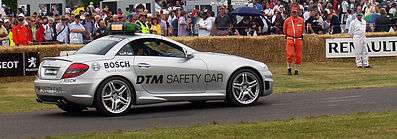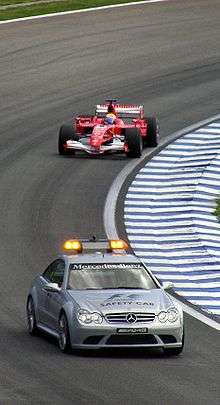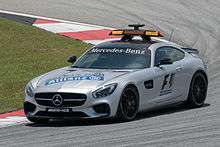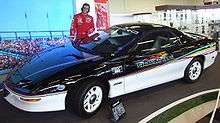Safety car

In motorsport, a safety car or pace car is a car which limits the speed of competing cars on a racetrack in the case of a caution period such as an obstruction on the track or bad weather. The aim of the safety car is to enable the clearance of any obstruction under safer conditions, especially for marshals and/or await more favourable track conditions weather-wise.
During a caution period the safety car (which generally consists of an aptly modified high-performance production car) enters the track ahead of the leader. Depending on the regulations in effect, competitors are not normally allowed to pass the safety car or other competitors during a caution period, and the safety car leads the field at a pre-determined safe speed, which may vary by series and circuit. At the end of the caution period, the safety car leaves the track and the competitors resume normal racing. The first reliance on this safety measure occurred with the deployment of a pace car during the inaugural Indianapolis 500 in 1911.[1]
Effect

The use of a safety car has the effect of bunching up competitors together, such as to eliminate any time and distance advantage that a leading driver may have had over the remaining field of competitors. This effect can make racing more competitive upon full race resumption; conversely, it has also contributed to faster leading drivers being negated just rewards for their efforts prior to the caution period.
Subject to the racing regulations in force, it is not uncommon for drivers to be allowed to make pitstops during safety car periods. This situation may provide a strategic advantage since, any scheduled refuelling, tyre change or maintenance may be carried out while other competitors are lapping at lower speed, and the drivers who pit then simply rejoin a queue of cars all running together. During normal racing conditions, such interventions would typically involve losing significant terrain over those drivers that remain on track.
Another notable effect of safety car periods is that racing cars consume less fuel until full race resumption, which can allow competitors to run longer distances on a tank of fuel than would otherwise have been possible and/or reduce the number of pitstops required for the duration of the race.
Formula One

Procedure
In Formula One if an accident or inclement weather (typically, heavy rain) prevent normal racing from continuing safely, the Race Director will call for a "safety car" period, which would see marshals wave yellow flags and hold "SC" boards, pending the car in question entering the track. From 2007, all Formula One cars must have LEDs and/or displays fitted to the steering wheel or cockpit, which inform the driver which flags are being waved. A yellow LED is illuminated when the safety car is deployed.
The safety car has both orange and green lights mounted on its roof in the form of a light bar. The green lights are used to signal that it is possible to overtake the safety car; this is only done until the race leader is immediately behind the safety car and at the head of the queue of race cars following.[2]

From 2015, the safety car is not required to wait until all backmarkers have caught back up to the queue. When the safety car is ready to leave the circuit, it will extinguish its orange lights to indicate that it will enter the pit lane at the end of the lap. Drivers must continue in formation until they cross the first safety car line, where circuit green lights and flags will indicate they are free to race again.[3]
The safety car is piloted by professional drivers (since 2000, by Bernd Mayländer) on-board high-powered modified vehicles supplied by Mercedes-Benz,[4] and must maintain a reasonable speed so as to ensure that the competitors' tyres are as close as possible to operating temperature and their engines do not overheat. The driver of the safety car is accompanied by a co-driver to assist with operations and communications.
For incidents during the first three laps, the safety car also has an advantage over the traditional red flag; with a red flag, it would take a minimum of fifteen minutes to restart the race, and the two-hour limit would not start until the cars were ready for a second formation lap. With regards to the time limit, the race is being scored and the time is also counting while the safety car is on the track, and the race resumes.
History
The first use of a safety car in Formula One is reported to have taken place at the 1973 Canadian Grand Prix, where a yellow Porsche 914[5][6] was called for duty following various incidents under treacherous weather conditions. Controversially, on that occasion, it took several hours after the race to figure out the winner and final results since the safety car driver had placed his car in front of the wrong competitor thus causing part of the field to be one lap down incorrectly.[7]

The sport officially introduced safety cars in 1993, after trials were conducted at both the French and British Grands Prix during the preceding 1992 season. Since 1996, as part of promotional arrangements, the supplier of safety cars has been Mercedes-Benz,[4] unlike previous years that have seen cars of different brands being used throughout the season and depending on the track visited (for example, the exotic Lamborghini Countach for the Monaco Grand Prix in the 1980s[6][6][8] to the more mundane Fiat Tempra used at the rain-affected 1993 Brazilian Grand Prix[9] and the high performance version of the Opel Vectra used at the infamous 1994 San Marino Grand Prix[10]).
From 2007, new procedures were applied for the first time during the Bahrain Grand Prix. The pit lane was closed immediately upon the deployment of the safety car. No car could enter the pits until all cars on the track had formed up in a line behind the safety car, they passed the pit entrance, and the message "pit lane open" was given. A ten-second stop/go penalty (which must be taken when the race is resumed) was imposed on any driver who entered the pit lane before the pit lane open message is given. However, any car which was in the pit entry or pit lane when the safety car was deployed would not incur a penalty.
From 2009, however, this procedure has been dropped, and replaced by software that calculates where a car is on the track and a minimum lap time it should take the car to get to the pits. Cars that enter the pits before this time limit has expired are penalised.
When the safety car and the drivers behind it are on the start/finish straight, there is a red light at the exit of the pit lane. Drivers who go past the red light are disqualified from the race. This has happened to several drivers during the years, such as Giancarlo Fisichella and Felipe Massa in the 2007 Canadian Grand Prix. At the same race a year later, Lewis Hamilton failed to notice the red light and slammed into the back of the car of Kimi Räikkönen, who was waiting at the end of the pit lane alongside Robert Kubica.
From 2010, once cars were lined up behind the safety car, lapped cars were no longer allowed to unlap themselves before the race was restarted.[11] This rule was abandoned from the 2012 season onwards, with cars now allowed to unlap themselves before the race resumes; however, since 2015, the safety car need not wait for the backmarkers to catch up with the leading pack before returning to the pits.
Virtual Safety Car (VSC)
Following an accident at the 2014 Japanese Grand Prix, which saw driver Jules Bianchi suffer a serious head injury which led to his death, the FIA established an Accident Panel to investigate the dynamics of the accident and ways to minimize the risk of a crash during similar circumstances that do not warrant the deployment of a safety car and cannot be simply managed with yellow flags.
The Panel recommended the implementation of a "Virtual Safety Car", based on the system used in Le Mans racing "slow zone". On top of not being allowed to overtake under yellow flag conditions in the affected sector, a "VSC" icon would appear trackside and on the driver's steering display, obliging drivers to not exceed the posted speed limit thus resulting in a 35% speed reduction. The system was similar to the Electro-PACER lights used in the Indianapolis 500 races from 1972 until 1978, except that ECUs were involved and could enforce speed limits under the current system.
The VSC was tested over the course of the final three races of the 2014 Formula One season, during parts of free practice sessions.[12][13] The system was evolved taking into account drivers' feedback and was officially introduced for the 2015 season following ratification by the World Motor Sport Council (WMSC).[14] The VSC was officially used for the first time — and for a brief period prior to the deployment of the actual safety car — at the 2015 Monaco Grand Prix, following a crash involving Max Verstappen. The system saw its first extended deployment at the 2015 British Grand Prix after Carlos Sainz, Jr's power unit failed at Club Corner of the Silverstone Circuit.
Indianapolis 500

The first use of a pace car in automobile racing was at the inaugural Indy 500 in 1911.[1] The officials at the Indianapolis Motor Speedway have been selecting a pace car and its driver for the Indy 500 each year since that first race. The first pace car was a Stoddard-Dayton driven by Carl G. Fisher. In recent years Chevrolet models have been chosen as the official pace car, owing to the ability for them to be used at both major automobile races at the Speedway (typically Corvette at the 500 and Impala at the 400). The pace car is selected two months before the race runs, allowing the manufacturer of the selected pace car to produce replicas of that year's car, which sell at a marked premium to collectors and race fans. Pace car replicas are often seen on the streets of Indianapolis weeks before the race is actually held, and a celebrity driver is usually used for the start of the race only.
Automakers compete for the prestige of having one of their models selected as the year's pace car for the publicity. In 1971, the move backfired as no automakers stepped up to provide a pace car. Instead, local Indianapolis-area Dodge dealers fulfilled the duty. Eldon Palmer, a local dealer, lost control of the Dodge Challenger pace car and crashed into a photography stand, injuring several people. The blame for the crash was never fully determined, as officials realized that an orange cone (or perhaps an orange flag), which was to identify Palmer's braking point, was accidentally removed.
In the last 50 years, the Pontiac Trans Am, Chevrolet Camaro, Chevrolet Corvette, Oldsmobile Cutlass, and Ford Mustang are the only models that have been selected as pace cars three or more times.
During the IndyCar Series season, however, Johnny Rutherford is the normal driver of the IRL pace car for all events. The pace car is deployed for debris, collision, or weather reasons. Since 1993, upon the waving of the yellow flag, pit road is closed until the pace car picks up the leader and he passes the pit entrance the first time, unless track blockage forces the field to drive through pit lane. Another duty of the pace car is to lead the field around the course on parade laps prior to the start of the race. These increase in speed, allowing for a flying start of the race.
Furthermore, two other rule changes have been implemented. Since 2000, with one lap to go before going back to green, the pace car pulls off the track in turn one rather than in turn four. The current leader of the race is then assigned the task of pacing the field back to the green flag. After much consideration, this rule was added to prevent a situation much like the one that happened in the 1995 Indianapolis 500, when Scott Goodyear passed the pace car going back to green. In 2002, another rule was added. With one lap to go before the green, the pace car waves by all cars (if there are any) between the pace car and the actual leader of the race. This allows for the leader to control the restart without lapped cars being in front of him. It also creates a strategy for cars to gain laps back, loosely resembling the "Lucky dog" rule. However, the cars who get waved around are not allowed to pit until the green flag restarts the race (so they do not get the advantage of getting their lap back AND a free pit stop).
NASCAR

In all NASCAR series, if the caution is out for debris, accident, or inclement weather, the flagman will display the yellow caution flag and the pace car [15] will pull out of the pits and turn on the yellow strobes on top and/or behind the car. One lap before a green flag, the pace car will shut off its lights to signal drivers to line up double file.
Unlike most series in motorsport, owing to NASCAR's short-track roots, each track usually offers their own safety car, typically from the manufacturer, but in recent years, it has been a local dealer or association of regional dealerships-provided Safety car. Tracks that use Toyota safety cars will use a Toyota Camry Hybrid, while Ford tracks will use a Ford Mustang, while Chevrolet tracks use a Chevrolet Camaro and most Dodge tracks use a Dodge Challenger. If a manufacturer is promoting a new vehicle, they will often use the new car instead of the standard-specification safety car.
For the Camping World Truck Series, often the safety car is a pickup truck, as the series races pickup trucks. Tracks affiliated with a local or regional Chevrolet dealership will use a Chevrolet Silverado, while Chrysler dealership affiliated tracks will use a Ram 1500. Ford-affiliated tracks will often use the F-Series, but Toyota-affiliated tracks are less likely to use the Toyota Tundra, but prefer marketing the Camry Hybrid. However, Ford and Toyota manufacturer sponsored tracks will prefer the Mustang and Camry, respectively, instead of a truck, and occasionally, pickup trucks have been used as pace vehicles for Sprint Cup and Xfinity races.
Since NASCAR does not allow speedometers or electronic speed limiting devices, the pace car circles the track at pit road speed during the warm-up laps. This allows each driver to note the RPM at which pit road speed is maintained. Drivers exceeding that speed on pit road will be penalized, typically a "drive-through" or "stop and go" penalty, costing them valuable track position.

Since mid-2004, NASCAR official Brett Bodine has driven the vehicle during official race functions during Sprint Cup Series races. Other famous NASCAR pace car drivers include Robert "Buster" Auton, Elmo Langley and Jay Leno.
The Beneficiary Rule (informally known as the "lucky dog" rule) states once the safety car is deployed, the first car not on the lead lap will regain a lap. The Beneficiary will regain his lap once pit road opens. Bodine will signal that car to pass him through radio contact between NASCAR and that team. The free pass car must pit with the lapped cars.
In 2009, NASCAR introduced a new "Double-file restart" rule that lines the field two cars on each row on every restart, similar to the start of the race, instead of lead-lap cars on the outside and lapped cars on the inside. Also, the "wave-around" rule, similar to what is enforced in the Indy Racing League was adopted to ensure the first car on the restart is the leader, and ensure there are no lapped cars ahead of the leader.
Incidents with safety cars and other course cars
2014 Sprint Unlimited
Before the start of the final segment of the Sprint Cup Series' Sprint Unlimited exhibition race at Daytona, the Chevrolet SS pace car caught fire and stopped off the track, delaying the restart. The fire was believed to have started in a trunk-mounted battery pack powering the lights.[16]
2012 Daytona 500
During a safety car situation on Lap 160 of the 2012 Daytona 500, Earnhardt Ganassi Racing driver Juan Pablo Montoya's car had a suspension part failure, and it lost control on turn 3, sharply veering right into a safety truck and jet dryer trailer, causing a massive diesel/jet fuel fire. As it was seen on video, sparks were seen emanating from Montoya's car right before its hard collision with the jet dryer trailer and left drivers side of the truck. Montoya was treated at the infield care center and released. Montoya's report over the radio after the incident was "I left the pits and felt a really weird vibration and I came back in and checked the rear end and said it was okay and I got into the backstraight and we were are going fourth gear but wasn't going that fast. Every time I got on the gas I could feel the rear squeezing. When I was telling the spotter to have a look how the rear was moving the car just turned right." The driver of the Chevrolet Silverado Crew Cab, Duane Barnes, was taken to a local hospital for observation and was resting comfortably. He was an employee at Michigan International Speedway, a sister track of Daytona. The tracks often share jet dryer equipment on race weekends to help in case of rain such as the case on Sunday, the original scheduled start time of the race. The entire incident took about two hours to clean up before the last 40 (later extended to 42 due to a Green-white-checkered finish) laps were able to be completed.
NASCAR subsequently added the use of the second safety car (used during race start situations) to protect the last jet dryer in other safety car situations.
2011 6 Hours of Castellet
The 2011 6 Hours of Castellet got off to a controversial start when the pace car did not return to the pits when the green lights came on. The front running LMPs slowed down but some of the GT cars could not react fast enough, resulting in heavy damage to all three GTE Pro class Porsches which caused them to retire. The GTE Am class IMSA Performance Matmut Porsche and GTE Pro JOTA Aston Martin were also caught up in the carnage.[17]
2009 WTCC Pau
An accident occurred during the 2009 FIA WTCC Race of France in Pau, France. A succession of first-lap accidents caused the safety car to be placed on standby, with yellow flags waving on the start-finish section of the track. The safety car driver then proceeded to drive onto the track at slow speed, without official approval,[18] moving across the pit exit line immediately after exiting the pits, instead of confining to the inside of it until the line ended. Race leader Franz Engstler came through the kink on the start-finish straight and was unable to avoid hitting the side of the pace car.[19] Engstler commented "I saw the safety car coming out from the right and realized that I had no chance to brake... I really do not understand why he was going out of the pits".[20] After this incident, the Portuguese Bruno Correia was appointed as the official safety car driver.[21]
2008 Dutch Supercar Challenge Spa
A safety car caused a crash during the 2008 Dutch Supercar Challenge race at Spa Francorchamps. The Seat Leon was released too late, allowing the leading Marcos LM600 to pass while erroneously identifying the Audi TT DTM in 2nd and Mosler MT900R GT3 in 3rd as 'the leading pack.' Race officials immediately realized their mistake, and the safety car was instructed to slow down and let the entire field pass.
As the safety car was exiting turn 11, an approaching Lamborghini Gallardo GT3 drastically reduced its speed in response to the unusually slow safety car. However, a BMW a few seconds behind came around the blind turn at speed, colliding with the Gallardo and safety car. The collision destroyed the Gallardo and sent the BMW into a number of rolls. The safety car was sent off the track into the Armco at great speed. In the chaos, a Marcos LM600 coming around turn 11 locked up its brakes and spun into the wet grass on the inside of the track. Sliding back onto the track, it was hit from the side by a BMW Z3. Furthermore, two E46 BMW M3 GTRs were damaged: one on the outside line hit the rear of the Marcos, and the other, on the inside line, slightly damaged its front right. The second M3 continued around the track, while the first slid into the grass before turn 12. The race was stopped, and there were no serious injuries to any of the drivers.
See also
- Zero cars, similar cars used in rallying to open roads to rally competitors.
- Pacemaker (running)
References
- 1 2 Cavin, Curt (May 16, 2011). "Leaders of the Pack". AutoWeek. Crain Communications Inc. 61 (10): 60–61.
- ↑ "Safety car". Retrieved 2010-11-07.
- ↑ https://www.formula1.com/content/fom-website/en/championship/inside-f1/rules-regs/Safety_car_Virtual_Safety_Car_and_Suspending_and_resuming_a_race.html
- 1 2 http://www.motorauthority.com/news/1082569_mercedes-benz-tells-the-history-of-the-f1-safety-car-video
- ↑ Kathri, Tarun (2012-02-07). "First ever Safety car in Formula 1 : Rewind to 1973". aaFormula1.com. Retrieved 2015-04-03.
- 1 2 3 "The F1 Safety Car's Bumpy Ride". 22 December 2007. Retrieved 3 April 2015.
- ↑ Lang, Mike (1982). Grand Prix! Vol 2. Haynes Publishing Group. p. 244. ISBN 0-85429-321-3.
- ↑ "Holy Ferruccio! A Lamborghini Countach Safety Car". Jalopnik. 2010-07-10. Retrieved 2015-03-03.
- ↑ http://www.enterf1.com/blog/049-the-bite-point
- ↑ http://www.carmagazine.co.uk/features/top-10s/the-car-top-10-f1-safety-cars
- ↑ "Cause and effect - the impact of 2010's new rules". Retrieved 2010-11-07.
- ↑ "Alonso: Still work to be done on VSC". PlanetF1.com. 31 October 2014. Retrieved 2 November 2014.
- ↑ "Virtual safety car gets the go-ahead". Planet F1. 3 December 2014.
- ↑ Noble, Jonathan (2 December 2014). "F1's virtual safety car system gets green light for 2015 debut". Autosport.
- ↑ David Caraviello (2007-10-01). "Rules aren't always what they appear in NASCAR". Nascar.com. Retrieved 2011-04-04.
- ↑ "NASCAR Pace Car Catches Fire During Sprint Unlimited at Daytona". Sports Illustrated. 2014-02-16. Retrieved 2014-07-04.
- ↑ "Start Chaos 2011 Le Mans Series at Le Castellet". MT89Motorsport2. 2011-04-03. Retrieved 2011-04-03.
- ↑ "Safety car had no permission to exit pits". Touringcartimes.com. Retrieved 2011-04-04.
- ↑ "Menu opens account amongst Pau mayhem". Crash.net. 2009-05-17. Retrieved 2011-04-04.
- ↑ "Video of the Engstler - Safety Car crash". Touringcartimes.com. Retrieved 2011-04-04.
- ↑ "WTCC APPOINTS PERMANENT SAFETY CAR DRIVER". AutoSport. Retrieved 6 March 2013.
External links
|
Formula One
- Formula1.com: Safety car
- An article on the F1 safety car
- The speed freak in F1's safety car - from BBC Sport: Motorsport